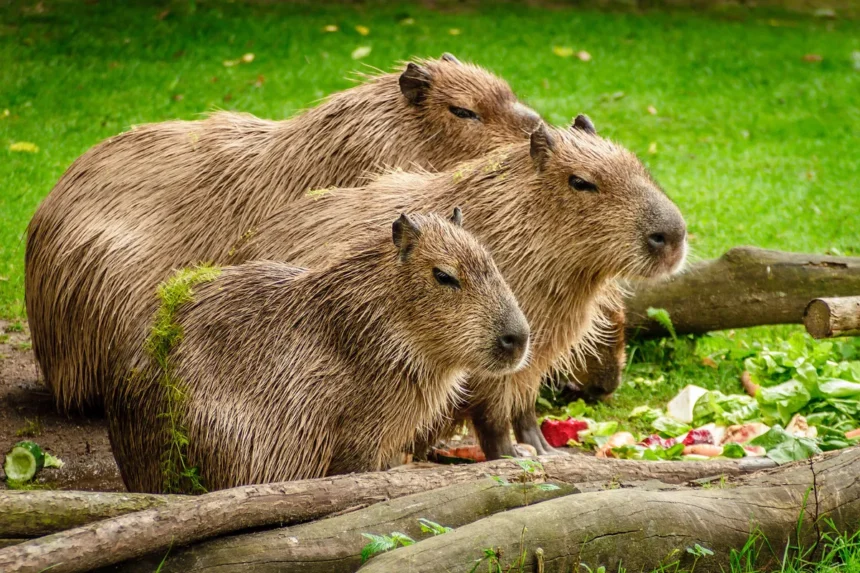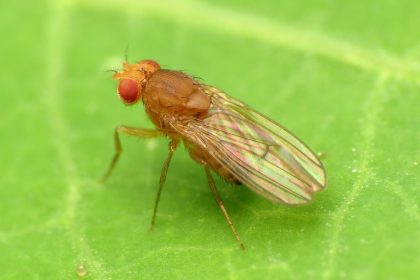Capybaras — The Largest Rodents in the World
These peaceful herbivores, native to South America, have large bodies with short legs and rounded snouts, making them the largest rodents in the world.
Capybaras are relatives of the well-known guinea pigs. In fact, this is why they are sometimes called water pigs. Indigenous peoples of Brazil call these animals kaapiara, which means “eater of thin grass”—hence the name we are familiar with.
Adult capybaras can weigh between 50-65 kilograms (110-143 pounds) and measure about 1.3 meters (4.3 feet) in length. Their height at the shoulder reaches up to 60 centimeters (24 inches). The largest capybaras recorded by scientists include a female from Brazil weighing 91 kilograms (201 pounds) and a male from Uruguay, reaching 73.5 kilograms (162 pounds).
Capybaras Swim and Run Well
Capybaras are excellent swimmers and can easily move in water thanks to their dense bodies and small webbing between their toes, similar to beavers, with whom they share a family connection.
They have anatomical features that help them survive in aquatic environments. Capybaras can hold their breath underwater for up to five minutes. Their eyes, ears, and noses are positioned high on their heads, allowing them to keep an eye on predators while submerged in ponds or rivers.
On land, capybaras are also quite adept. These rodents can reach speeds of up to 35 km/h, helping them escape predators.
Capybaras Are Social Creatures
Capybaras are highly social. A typical group consists of about 10 animals. However, during the rainy season, the number of members can reach 40, and in the dry season, they can form herds of up to 100 individuals, led by a dominant male.
Capybaras are most active at dawn and dusk, but if they sense danger, they may stay awake at night and rest during the day. Darkness helps protect them from predators while they feed.
Capybaras use a wide variety of sounds to communicate with each other. This can include barking, clucking, grunting, purring, squealing, and long whining sounds.
They also loudly grind their teeth, using this as another form of communication.
The meaning of the sounds capybaras make varies depending on the context—it can be a warning about a nearby predator, a signal of friendliness, or even an indicator of weather conditions.
Capybaras are friendly and welcoming, even toward other species. There are many documented cases of capybaras accepting orphaned or abandoned animals into their groups. They allow birds, rabbits, and even monkeys to ride on their backs in the wild, and in captivity, they are known to befriend cats and dogs.
Capybaras are also tolerant of humans and gladly allow people to pet them. However, you should avoid touching wild capybaras, as they can transmit Lyme disease and Rocky Mountain spotted fever to humans. The latter is fatal for children, who are often the first to want to hug these cute, fluffy animals.
Capybaras’ Eating Habits Are Quite Peculiar
The primary diet of capybaras consists of various plants. They graze in fields, consuming grasses and cereals. They also eat young shoots, branches, bark, and leaves from different trees and shrubs. Additionally, they may consume aquatic plants, such as cattails, water lilies, and water spinach.
Capybaras also eat fruit when available or when offered by people.
They enjoy oranges, pears, and watermelons.
However, these cute animals regularly engage in a rather unpleasant behavior known as autocoprophagy.
You see, unlike ruminant animals, capybaras cannot afford such long intestines, so they don’t digest fiber very efficiently. As a result, they eat their own feces to literally digest their food a second time. This way, capybaras obtain more nutrients and can reclaim water lost during defecation.
Additionally, capybaras sometimes regurgitate the contents of their stomachs, chew it a little, and swallow it again, which aids digestion. Cows, for example, do this as well.
Capybaras Can Be Eaten During Lent
At this point, you might exclaim—how could anyone eat these adorable creatures? But capybaras are indeed consumed in some regions of South America.
This rodent is part of traditional cuisine in countries like Brazil, Venezuela, Colombia, and others.
Capybara meat has a distinctive taste and is considered a delicacy in certain regions. It can be prepared in various ways and used in different dishes.
South American Catholics, in particular, have a fondness for capybara—culinarily speaking.
In some regions of South America, especially in Venezuela, capybaras are eaten during Lent and Holy Week. This is because the Catholic Church issued a special dispensation allowing these animals to be consumed during this time, while other meats are prohibited. This papal bull was issued in 1784.
The logic of the Pope was understandable. Beavers had been allowed as food during Lent since the Middle Ages because they live in water, and thus, were considered akin to fish, which is permissible during Lent. Capybaras are similar to beavers—both are rodents, both enjoy swimming—so their meat was deemed acceptable as well.






